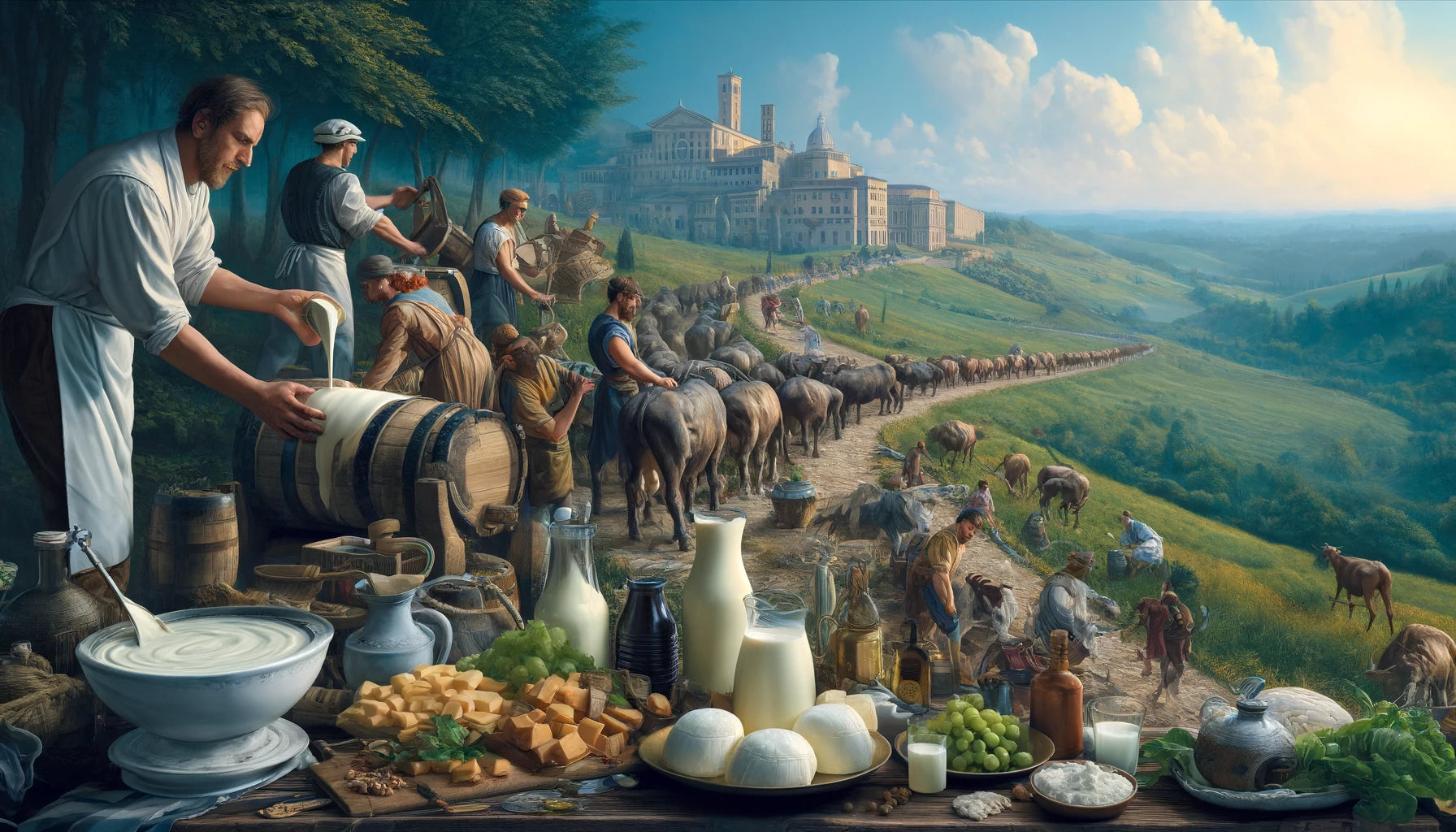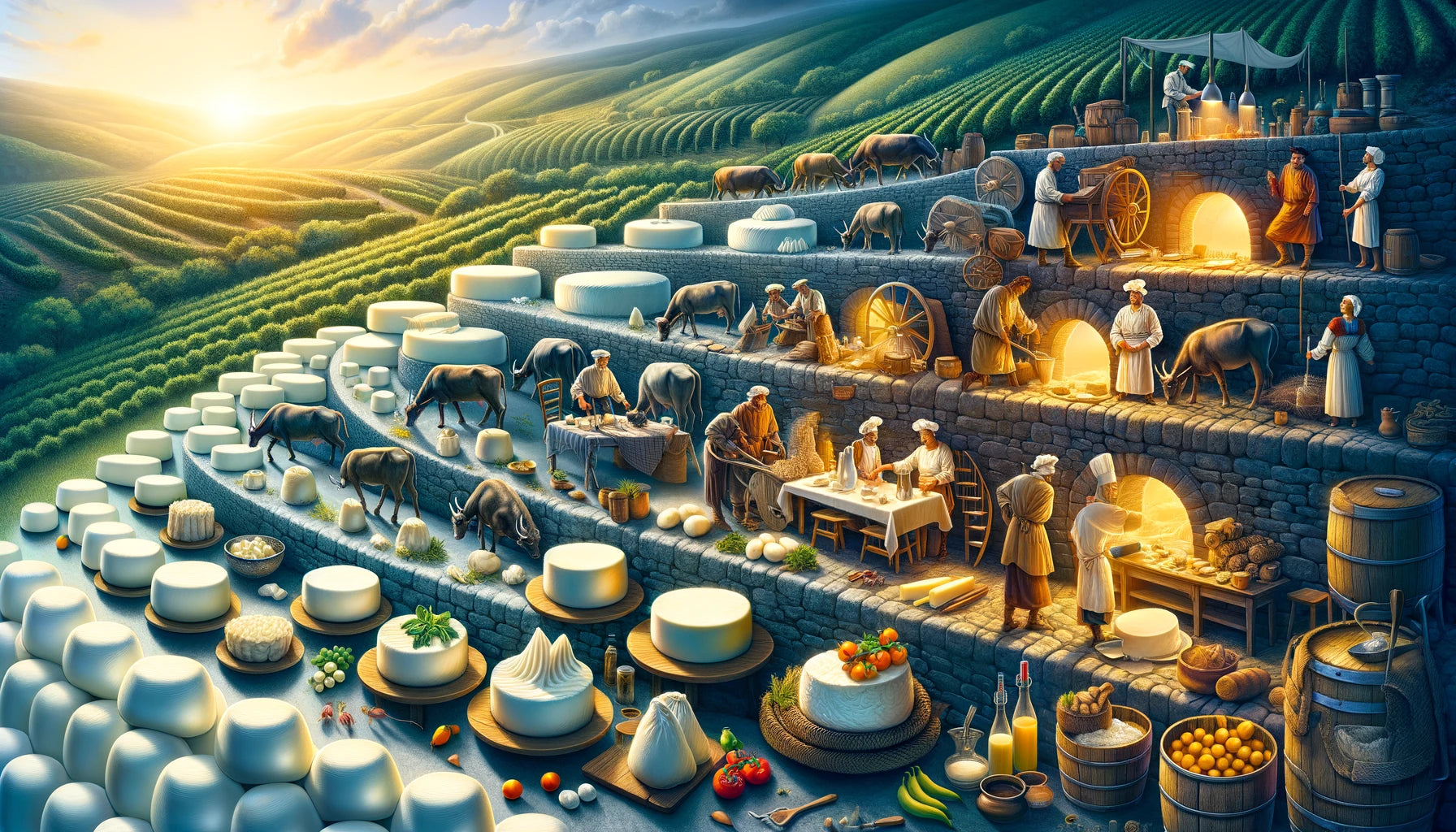Historical Evolution of Mozzarella Cheese
Mozzarella Cheese, a name synonymous with the creamy, melt-in-your-mouth texture that has become a cornerstone of cuisines worldwide, embarks on a journey as rich and layered as its flavor. This narrative traces the origins and evolution of mozzarella cheese from its humble beginnings in ancient Italy to its contemporary status as a beloved ingredient across the globe. Along this fascinating culinary voyage, we will explore the traditional methods that imbue mozzarella with its distinctive characteristics, and how this iconic cheese has adapted to the tastes and demands of modern consumers, including the advent of vegan and plant-based alternatives.
The story of mozzarella is one of craftsmanship, cultural exchange, and culinary innovation. It begins in the verdant landscapes of Southern Italy, with the introduction of water buffalo, whose milk would become the cornerstone of mozzarella cheese. The cheese's journey is marked by the artistry of the pasta filata process, a testament to the skill and tradition of Italian cheesemakers. As we delve into the renaissance of mozzarella, we'll uncover how this local delicacy transcended its regional roots to captivate food enthusiasts around the world, evolving in form and flavor to meet the growing demands of a global market.
The Fascinating Journey of Mozzarella: From Ancient Italy to Global Kitchens
Mozzarella Cheese, with its rich history and creamy texture, has captivated the taste buds of millions worldwide. This article embarks on an exploratory journey into the historical evolution of mozzarella cheese, tracing its roots from ancient Italy to its present-day status as a global culinary staple. Along the way, we'll delve into the traditional production methods that give mozzarella its unique character and explore how it has adapted to meet the demands of modern consumers, including the rise of Vegan Cheese and plant based cheese alternatives.
The Ancient Origins of Mozzarella: A Tale of Milk and Mastery
Mozzarella's story begins in the lush landscapes of Southern Italy, where it was first crafted from the rich milk of water buffaloes. Historical records suggest that as early as the first century AD, the Romans were producing a precursor to mozzarella from sheep's milk. However, it wasn't until the introduction of water buffalo to Italy, around the 12th century, that mozzarella began to take the form we recognize today.
The art of mozzarella making is deeply rooted in the pasta filata method, where the cheese curd is heated and then stretched and kneaded to achieve its characteristic elasticity. This method, which translates to spun paste, is what gives mozzarella its distinctive texture and appearance. The term mozzarella itself is derived from the Italian verb mozzarella cheese block, meaning to cut or separate, referring to the process of cutting the cheese into individual pieces during production.

The Renaissance of Mozzarella: From Local Delicacy to International Sensation
The transition of mozzarella from a local specialty to an international sensation is a testament to the adaptability and enduring appeal of this cheese. Initially, mozzarella was a perishable product, with a very short shelf-life, limiting its consumption to the regions near Naples where it was produced. The situation began to change with advancements in cheese technology, refrigeration, and transportation in the 20th century, allowing mozzarella to travel beyond the Italian borders and capture the hearts of cheese lovers around the world.
As mozzarella's popularity soared, so did the variety of its forms. Traditional mozzarella di bufala, made from buffalo milk, remains highly prized for its rich taste and creamy texture. However, the demand for mozzarella has led to the production of cow's milk varieties, such as Fior di Latte, and innovations like low-moisture mozzarella for pizza, showcasing the cheese's versatility.
Embracing Modernity: Mozzarella's Evolution in the Age of Dietary Diversity
In the face of changing dietary preferences and an increased focus on health and sustainability, mozzarella has continued to evolve. The rise of veganism and plant-based diets has led to the creation of mozzarella alternatives made from various plant sources. vegan cheese and plant based cheese products, crafted from nuts like cashews or almonds, have become popular for those seeking dairy-free options without sacrificing the joy of mozzarella. These alternatives often incorporate Cashew Butter or coconut oil to achieve the creamy texture reminiscent of traditional mozzarella.
Moreover, the culinary applications of mozzarella have expanded significantly. Beyond its iconic role in pizzas and lasagnas, mozzarella is now celebrated in a variety of dishes, from sophisticated appetizers to gourmet salads, highlighting its versatility. The introduction of flavored mozzarella varieties, such as Garlic Butter and Unsalted Butter mozzarella, has further broadened its culinary appeal.
Mozzarella: A Culinary Journey Through Time
Mozzarella cheese, with its delicate texture and rich history, is a testament to the ingenuity of traditional cheese-making and the evolution of culinary practices. This journey from its humble beginnings in the Italian countryside to its place in the hearts of food lovers worldwide is a fascinating story of adaptation, innovation, and cultural exchange. In this comprehensive exploration, we delve into the origins of mozzarella, its traditional and modern production methods, and its significance in today's global culinary landscape, including the emergence of vegan and plant-based alternatives.
The Origins and Historical Evolution of Mozzarella
The story of mozzarella begins in the Campania region of Italy, where the lush landscape provided the ideal conditions for raising water buffaloes, whose milk is the original base for this cheese. Historical records suggest that mozzarella's ancestors were first made in monastic cells by Italian monks. The term mozzarella itself is derived from the action mozzare, meaning to cut off, reflecting the process of hand-pulling and pinching off pieces of the cheese.
- Ancient Beginnings: The roots of mozzarella can be traced back to the Roman Empire, where early forms of cheese resembling mozzarella were made from sheep's milk.
- Buffalo Milk Revolution: The introduction of water buffalo from India to Italy around 600 AD transformed cheese-making in Southern Italy. Buffalo milk's richness was superior to that of cow's or sheep's milk, leading to the creation of a softer, more flavorful cheese.
- Medieval Expansion: By the Middle Ages, mozzarella had become a staple in the Italian diet, especially within the monastic communities that played a crucial role in refining the cheese-making process.
The Artisanal Process: Traditional Mozzarella Making
Mozzarella's unique texture and flavor are the results of a meticulous artisanal process known as pasta filata. This method involves heating the curd to a point where it becomes elastic, allowing it to be stretched and kneaded into the familiar shapes we love today.
- Pasta Filata Method: The curds are first acidified, then heated in water until they reach a stretchable consistency. The cheese maker then hand-pulls the curds, shaping them into balls or braids.
- Mozzarella di Bufala Campana DOP: This designation ensures that only mozzarella made from the milk of water buffaloes raised in specific regions of Italy can carry this prestigious title. The DOP (Denominazione di Origine Protetta) status guarantees the cheese's authenticity and quality.
Modern Adaptations: Meeting Global Demands
As mozzarella's popularity grew beyond the borders of Italy, adaptations were necessary to meet the demands of a global market. This led to innovations in production methods and the introduction of new varieties of mozzarella, including those made from cow's milk, known as Fior di Latte.
- Global Spread: Advances in refrigeration and transportation in the 20th century allowed mozzarella to become a global phenomenon, appearing in dishes worldwide.
- Industrial Production: To cater to international demand, mozzarella is now also produced industrially, allowing for longer shelf life and greater accessibility.

Mozzarella in the Culinary World
Today, mozzarella is celebrated not just for its role in Italian dishes like pizza and Caprese salad but as a versatile ingredient in various cuisines. Its mild flavor and melt-in-your-mouth texture make it a favorite among chefs and home cooks alike.
- Culinary Versatility: Beyond traditional Italian recipes, mozzarella is used in a variety of dishes, from appetizers to desserts, showcasing its adaptability to different culinary contexts.
- Innovative Flavors: The market has seen the introduction of smoked mozzarella, herbed varieties, and even mozzarella infused with truffles, expanding its appeal and usage in cooking.
The Rise of Vegan and Plant-Based Alternatives
The increasing demand for vegan and plant-based diets has led to the creation of mozzarella alternatives. These products are designed to mimic the texture and taste of traditional mozzarella without using animal-derived ingredients, catering to the dietary preferences and ethical considerations of a broad audience.
- Vegan Cheese Innovations: Made from nuts, soy, or coconut oil, vegan mozzarella alternatives offer a dairy-free option for those looking to enjoy the cheese's versatility without compromising their dietary choices.
- Environmental and Ethical Benefits: The production of plant-based mozzarella alternatives often has a lower environmental impact, aligning with the growing consumer interest in sustainable and ethical eating practices.
Conclusion: Mozzarella's Enduring Legacy and Future Prospects
The historical evolution of mozzarella cheese from an artisanal Italian product to a global culinary staple is a fascinating story of tradition, innovation, and adaptation. As we look to the future, mozzarella's journey is far from over. With ongoing trends towards dietary diversity, sustainability, and global fusion cuisines, mozzarella – in both its traditional and plant-based forms – is set to continue its reign as one of the world's most beloved cheeses. Whether enjoyed in its classic Unprocessed Cheese form, as a flavorful parmigiano-reggiano topping, or as a fat free cheese alternative, mozzarella's place at the table is assured for generations to come.
Mozzarella's versatility, rich history, and adaptability to changing culinary trends and dietary preferences underscore its unique position in the cheese world. From its origins in ancient Italy to its status as a modern kitchen staple, mozzarella's journey is a testament to the enduring appeal of simple, high-quality ingredients transformed through time-honored techniques and innovation. As we embrace the future, the story of mozzarella is set to continue, promising new flavors, formats, and possibilities for cheese lovers everywhere.








